Ecommerce personalization creates unique experiences tailored to each shopper.
That’s a pretty loaded, yet vague, phrase. What exactly is a unique experience? How does it work? Do I need personalization? Why? Where do I use it?
In this article, we’ll break down all those questions, provide examples, and discuss how you can use personalization to sell more.
What is Ecommerce Personalization?
At its root, Ecommerce Personalization takes shopper data and displays relevant products on your site. Personalization providers compile this data based on on-site browsing habits, previous purchases, and location.
Think of a streaming service homepage. The layout is the same for everyone, but the selections are different. Streaming services use data on each user to make relevant viewing suggestions.
As an example, take a look at one person’s streaming service homepage vs their spouse’s.
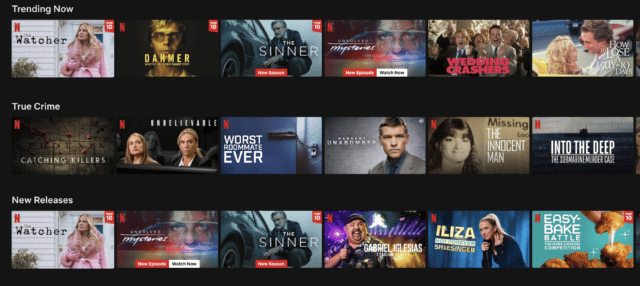
The Author’s Streaming Service Homepage
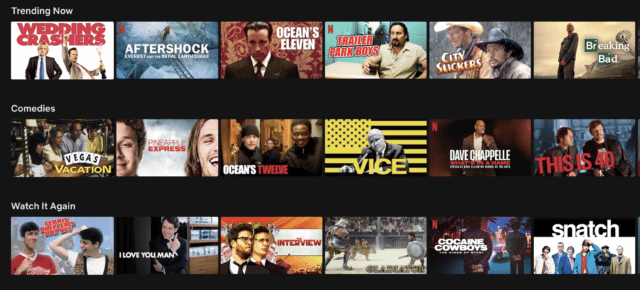
The Author’s Spouse’s Streaming Service Homepage
The “Trending Now” category shows each viewer options they are more likely to watch. Following “Trending Now” displays categories that the streaming service thinks each user would enjoy. Everything is tailored to the viewer. While one obviously enjoys true crime (effectively fulfilling a millennial woman stereotype), romantic comedies, and series with strong female leads, the other tends toward late night comedies and gritty drama’s. Even the cover art is targeted to the individual viewer. The movie “Wedding Crashers” shows up on both profiles, however, the cover art for the first one gives the feeling of a happy wedding celebration, while the second profile gives off more of a party, bachelor vibe.
Streaming services use data from previous watched and searched movies and tv shows, and user demographics and preferences provided when setting up a profile.
Although ecommerce personalization looks a little different, the general idea is still the same. Providing a personalized experience not only boosts conversions, it also builds loyalty. A staggering 80% of consumers are more likely to buy from a company that provides a personalized experience. In fact, 70% of shoppers say they are more loyal to brands that understand their needs.
To be competitive in today’s ecommerce world, personalization is no longer just a nice-to-have, it’s a must-have.
In ecommerce, personalization is similar to steaming service’s personalization, but placement is more strategic. There are several ways to include personalization on your online store. These include:
- Personalized Product Recommendations
- Personalized Search and Merchandising
- Personalized Email Recommendations
Ecommerce personalization is the best way for an online store to mirror an in-person shopping experience. When shoppers visit a brick-and-mortar location, they receive personal attention from a salesperson who learns their needs and helps them find relevant products. The salesperson will also upsell complimentary items and give recommendations on similar items that may fit the shopper’s needs better. In other words, they get to know the customer and build a relationship. An in-person sales associate and personalization have the same goal – just a different path to get there.
Personalized Product Recommendations
Personalized product recommendations provide unique recommendations to shoppers based on previous on-site behavior.
We all know what recommendations look like at a basic level. It’s likely that your ecommerce platform offers some sort of blanketed recommendations, but for product recommendations to be effective, they need to be personalized. If you’re serving the same set of recommended products to each shopper, they aren’t personalized.
For a truly personalized experience, use an ecommerce personalization tool that integrates with your online store. Personalization providers, like Searchspring, place a widget on your site to learn shopper behavior and show shoppers relevant products. The more a shopper visits your site, the better the personalized experience becomes.
Cycling retailer, PEARL iZUMi works to create a better planet through building a strong cycling community. One way they help build their community is by making connections through personalized product recommendations. By recognizing their customers as individuals with their own special set of needs, PEARL iZUMI is more likely to win that shopper over and build loyalty and trust in addition to higher conversion rates.
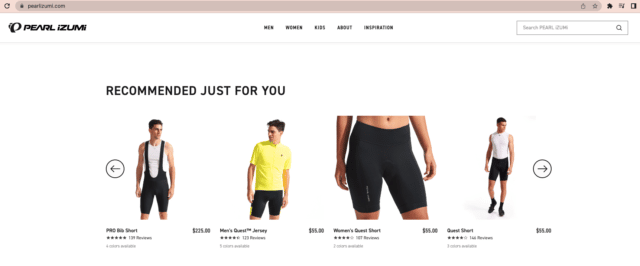
PEARL iZUMI “Recommended Just For You” Personalized Product Recommendations
Between January 1 and October 18, 2022, PEARL iZUMI experienced a 34.2% impression rate from Personalized Product Recommendations.
[stat align=”left” format=”box” width=”” preText=”PEARL iZUMI Has a” number=”34.2%” postText=”Product Recommendations Impression Rate” bgColor=”pink”]
There are several types of personalized product recommendations ecommerce sites can utilize.
- Cross-Sell Recommendations
- Session Recommendations / Similar Recommendations
- Geo-Merchandising
- Trending Products / Best Sellers
Let’s take a closer look at the difference between these types of recommendations and how they can help you boost conversions.
-
Cross-Sell Recommendations
Cross-Sell recommendations are products that a shopper should consider purchasing in addition to the item they are currently viewing. For example, if someone purchases a woman’s sweater dress, they’re going to need tights, boots, and jewelry to bring the look together. The same idea applies if a shopper purchases something like indoor paint. What are they going to need to get the job done? Primer, paint brushes and rollers, paint tray, and tape.
Putting together a collection of items helps the shopper find relevant products faster and provides a better shopper experience. So while the shopper gets their needs met, you increase Average Order Value (AOV). A win-win.
Inspirational gift, home goods, and clothing boutique, Natural Life, gives their shoppers a complete shopping experience by showing them how to “Complete the Look”. In the example below, Natural Life previews items to make a whole bedding set.
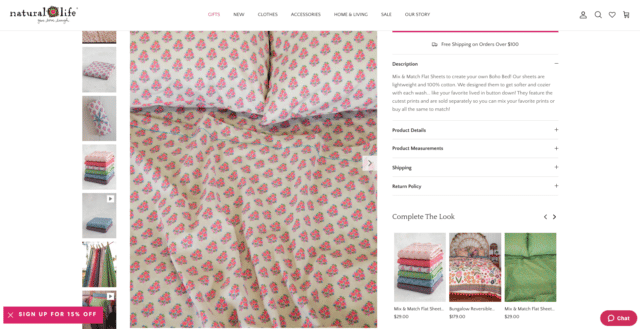
Natural Life Cross-Selling Using “Complete This Look”
-
Session Recommendations and Similar Recommendations
Similar recommendations and session recommendations do basically the same thing but with different base factors. Both display alternative, but similar products to the one the shopper previously viewed. The difference is that session recommendations show these products within the current visit only. Similar recommendations carries these suggestions to later visits. Another difference is that similar recommendations are also used to upsell, while session recommendations are a little more basic.
Session recommendations improve relevancy by leveraging user data to make quick decisions during that specific visit to your ecommerce site. Using data from the session the shopper is currently in, session recommendations recommends alternative products based on recently viewed items.
Rugs USA uses similar recommendations to suggest multiple alternatives to the product the shopper is currently viewing.
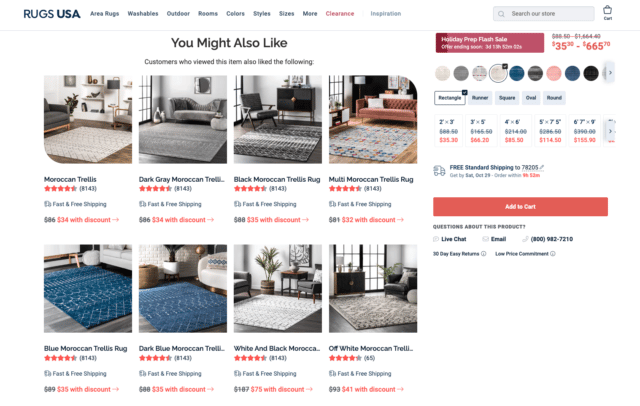
Rugs USA Similar Recommendations
-
Geo-Merchandising
Another awesome ecommerce personalization feature is geo-merchandising. Advanced personalization tools, like Searchspring, should have this feature available. Geo-Merchandising dynamically displays relevant products to online shoppers based on their location. With this personalization feature, you can show shoppers seasonally-appropriate apparel, merchandise for their local sports team, or home and garden products that reflect their local climate for the best relevancy.
Think of it like this: let’s say you run a pet supply store. As winter storms hit northern states, it’s a good idea to feature winter items to shoppers from those regions. However, dog boots, warm sweaters, and products to keep your dogs water from freezing aren’t relevant to shoppers basking in the sun on a beach in Miami.
So how do you show winter pet items to someone in Minnesota, but show t-shirts and regular pet bowls to someone in Texas? Geo-merchandising.
A good example of geo-merchandising is ecommerce site, Reef. They go about it a little differently than the example mentioned above and show trending products based on the shopper’s location.
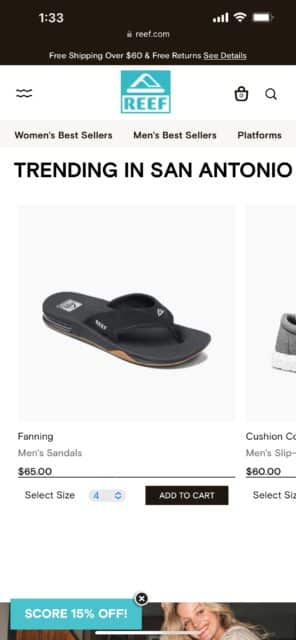
Reef Geo-Merchandising
-
Trending Products and Best Sellers
To display relevant products to shoppers, show them items that help them stay relevant. Feature trending items and best sellers so visitors to your site can research popular items. Use Insights and Reporting to gather this info and to gain a better understanding of your target audience.
Home brand, Bed Threads, not only uses best sellers (“Most Popular”) to highlight overall best sellers, they also segment out best sellers by product type. In the example here, they use “Shop Our Best-Selling Bedding Bundles”. As the shopper scrolls down the page, they see other best sellers by category including “Shop Our Best-Selling Table Bundles”.
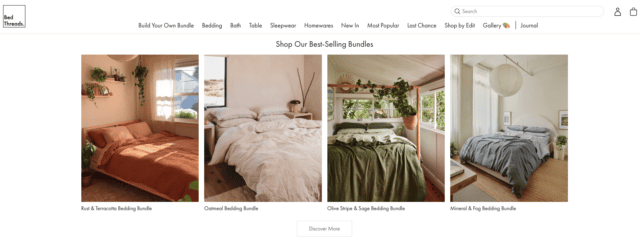
Bed Threads Uses Best Selling Recommendations in Multiple Ways
Personalized Search and Merchandising
Ecommerce Personalized Search and Merchandising displays relevant products in search results based on previous shopping behavior. All the same items that appear in regular search results show up, but Personalized Search and Merchandising prioritizes products each individual shopper is more likely to purchase by displaying them first.
Shoe retailer, Peltz Shoes started using Personalized Search and Merchandising in 2022 and immediately saw results. In a matter of weeks, they experienced a 12.9% increase in conversions attributed to Personalized Search and Merchandising.
In the example below, the shopper previously browsed hiking sandals. When they returned later and performed a search for “Sandals Women”, the first results are directly related to previous shopper behavior.
It’s worth noting that most native platforms simply can’t provide this feature, so an ecommerce personalization tool is needed.
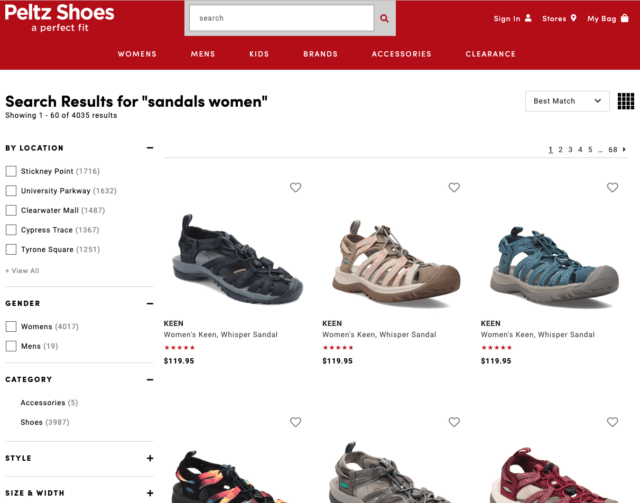
Peltz Shoes Displays Search Results Based on Shopper Behavior
Personalized Email Recommendations
It’s easy to recommend products through email. It’s a bigger deal to really personalize them. Show recommendations and craft messaging especially for each individual shopper in follow-up messages, just like you do on your website.
Personalized email recommendations not only help create custom product recommendations, they can also be used for messages such as care instructions and reminders (ie: time for new tires).
Additional Personalized Email Recommendations use-cases include:
- Post-purchase
- Cart abandonment reminder
- Upcoming sales
- Recommended products (“Picked Just for You”)
- Just dropped and on sale items similar or complementary to previous shopping behavior
- Loyalty program and points information

Reasons to Implement Ecommerce Personalization
-
Build Customer Loyalty
Make a customer feel special and you create a customer for life. Ecommerce personalization builds customer loyalty by creating tailored experiences for each individual shopper.
Imagine that you are shopping at an online bookstore and you happen love romance novels. After a couple visits, this online bookstore starts to recommend books by your favorite author and even alerts you when a new book by them is available. Where do you think you are going to buy your books? The bookstore you have to search through to find your favs, or the one that already knows what you like and anticipates what you are looking for?
Time and again, you’re more likely to buy from the store that makes it easiest to find what you’re looking for.
-
Create an Engaging Shopper Experience
The online shopping experience should be just as engaging as an in-person shopping experience. When we visit a store, we receive recommendations, customer service, and a personal experience.
Not every person who walks through the door is treated like the person before them. Why? Because we’re individuals. Some people are looking for shoes. Some are looking for watches. Some are looking for hats. What sets one person apart from another person looking for these same items is their personality.
A store associate is able to tap into the customers personality and create an experience made especially for them. The best way to replicate that experience online is through personalization.
-
Get the Right Product in Front of the Right Customer
There is nothing more frustrating to a customer than knowing a product they are looking for is there and not being able to find it. Personalization gets to know the customer and understands what they are looking for, taking that frustration out of the equation.
Personalization gets the right product in front of the right customer at the right time.
For example, personalization knows that someone searching “romper” who has never searched for children’s clothing in the past would not be likely to be searching for children’s rompers. Women’s size rompers are pushed to the top of the page children’s and baby rompers to the bottom.
-
Control the Narrative
Personalization gives you more power and control over messaging. From product discovery to post-purchase communication, what the customer sees – and how they see it – is up to you.
Your team can merchandise and group products to your liking and communicate to shoppers however you see fit. Between Personalized Search and Merchandising, Personalized Product Recommendations, Geo-Recommendations, and Email Recommendations, you have complete control over the narrative of your product.
-
Better User Experience
Ecommerce and digital marketing are to the dot com world what Scottie Pippen and Michael Jordan were to basketball. What John Lennon and Paul McCartney were to songwriting. What Ron Weasley was to Harry Potter. If you don’t understand these references, it’s a pretty big deal.
In digital marketing, it’s all about the User Experience, or UX. From homepage to checkout, make sure you’re providing the best user experience for your customer. Personalization helps you do that.
What better way to provide a great user experience than to create one tailored just for that customer?
-
Increased Likelihood of Conversions
When customers feel taken care of, can find what they’re looking for, and are given a great shopper experience, they’re more likely to convert. There isn’t much more to it than that.
Not only are they more likely to convert, they’re more likely to add more to their cart and tell their family and friends about their experience.
Personalization creates an environment where the customer feels like they are understood and cuts all the noise and frustration out of finding what they need. At the end of the day, personalization is a part of good, old customer service.
How to Implement Ecommerce Personalization on Your Site
Most ecommerce platforms offer basic recommendations, however, they are blanketed items that show the same set of products to each customer. To provide a personalized experience, a specialized ecommerce personalization solution is needed. There are a few plug-in options, but they tend to be complicated, unreliable, and don’t offer any support. Your best bet is to find a simple, easy-to-use product that meets your needs, and can help you and your team strategize for maximum results.
View Searchspring’s Personalizing the Shopper Experience webinar below and let us know if you have any questions.
Sign up for future Searchspring webinars, or watch previous ones on-demand to stay on top of current trends and optimization techniques from ecommerce industry experts.




